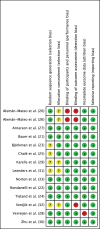The Impact of Dairy Protein Intake on Muscle Mass, Muscle Strength, and Physical Performance in Middle-Aged to Older Adults with or without Existing Sarcopenia: A Systematic Review and Meta-Analysis
- PMID: 30624580
- PMCID: PMC6370271
- DOI: 10.1093/advances/nmy065
The Impact of Dairy Protein Intake on Muscle Mass, Muscle Strength, and Physical Performance in Middle-Aged to Older Adults with or without Existing Sarcopenia: A Systematic Review and Meta-Analysis
Abstract
Sarcopenia is an age-related condition associated with a progressive loss of muscle mass and strength. Insufficient protein intake is a risk factor for sarcopenia. Protein supplementation is suggested to improve muscle anabolism and function in younger and older adults. Dairy products are a good source of high-quality proteins. This review evaluates the effectiveness of dairy proteins on functions associated with sarcopenia in middle-aged and older adults. Randomized controlled trials were identified using PubMed, CINAHL/EBSCO, and Web of Science databases (last search: 10 May 2017) and were quality assessed. The results of appendicular muscle mass and muscle strength of handgrip and leg press were pooled using a random-effects model. The analysis of the Short Physical Performance Battery is presented in narrative form. Adverse events and tolerability of dairy protein supplementation were considered as secondary outcomes. Fourteen studies involving 1424 participants aged between 61 and 81 y met the inclusion criteria. Dairy protein significantly increased appendicular muscle mass (0.13 kg; 95% CI: 0.01, 0.26 kg; P = 0.04); however, it had no effect on improvement in handgrip (0.84 kg; 95% CI: -0.24, 1.93 kg; P = 0.13) or leg press (0.37 kg; 95% CI: -4.79, 5.53 kg; P = 0.89). The effect of dairy protein on the Short Physical Performance Battery was inconclusive. Nine studies reported the dairy protein to be well tolerated with no serious adverse events. Although future high-quality research is required to establish the optimal type of dairy protein, the present systematic review provides evidence of the beneficial effect of dairy protein as a potential nutrition strategy to improve appendicular muscle mass in middle-aged and older adults.
Figures






Comment in
-
Reply to NI Hanach et al.Adv Nutr. 2020 Jan 1;11(1):175-176. doi: 10.1093/advances/nmz067. Adv Nutr. 2020. PMID: 31945781 Free PMC article. No abstract available.
References
Publication types
MeSH terms
Substances
LinkOut - more resources
Full Text Sources
Miscellaneous

